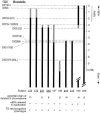The Turner syndrome-associated neurocognitive phenotype maps to distal Xp
- PMID: 10931762
- PMCID: PMC1287527
- DOI: 10.1086/303039
The Turner syndrome-associated neurocognitive phenotype maps to distal Xp
Abstract
Turner syndrome (TS) is associated with a characteristic neurocognitive profile that includes impaired visuospatial/perceptual abilities. We used a molecular approach to identify a critical region of the X chromosome for neurocognitive aspects of TS. Partial deletions of Xp in 34 females were mapped by FISH or by loss of heterozygosity of polymorphic markers. Discriminant function analysis optimally identified the TS-associated neurocognitive phenotype. Only subjects missing approximately 10 Mb of distal Xp manifested the specified neurocognitive profile. The phenotype was seen with either paternally or maternally inherited deletions and with either complete or incomplete skewing of X inactivation. Fine mapping of informative deletions implicated a critical region of <2 Mb within the pseudoautosomal region (PAR1). We conclude that haploinsufficiency of PAR1 gene(s) is the basis for susceptibility to the TS neurocognitive phenotype.
Figures


References
Electronic-Database Information
-
- Genome Database, The, http://www.gdb.org/
-
- Integrated X Chromosome Database, http://ixdb.molgen.mpg.de/
References
-
- Allanson JE, O'Hara P, Farkas LG, Nair RC (1993) Anthropometric craniofacial pattern profiles in Down syndrome. Am J Med Genet 47:748–752 - PubMed
-
- Belin V, Cusin V, Viot G, Girlich D, Toutain A, Moncla A, Vekemans M, Le Merrer M, Munnich A, Cormier-Daire V (1998) SHOX mutations in dyschondrosteosis (Leri-Weill syndrome). Nat Genet 19:67–69 - PubMed
-
- Bender B, Puck M, Salbenblatt J, Robinson (1984) A cognitive development of unselected girls with complete and partial X monosomy. Pediatrics 73:175–182 - PubMed
Publication types
MeSH terms
Grants and funding
LinkOut - more resources
Full Text Sources
Medical
Miscellaneous

